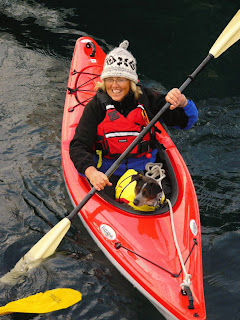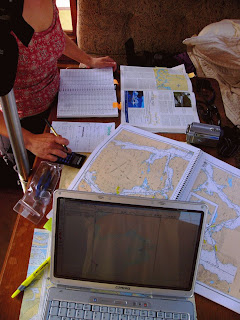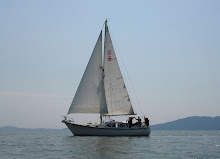 Delectables and delicates, finally with a little rain, the shrooms are coming out and splotching the forest with some much-appreciated color.
Delectables and delicates, finally with a little rain, the shrooms are coming out and splotching the forest with some much-appreciated color.  This little treasure was candy-apple red and about the size of a mouse.
This little treasure was candy-apple red and about the size of a mouse. After one of our forest collecting forays, we ran into some kindred spirits. Again. Keith and Heather are former Canada Parkies and recently moved from sea kayaks to a sailing trimaran. We've been bumping into them in the same anchorages, and finally got to have them aboard for a boat tour. They've now live in Alberta, but kayaked these coasts for years. We've really enjoyed swapping Park Service stories with them and hope to meet up this winter for some backcountry skiing in the Rockies.
After one of our forest collecting forays, we ran into some kindred spirits. Again. Keith and Heather are former Canada Parkies and recently moved from sea kayaks to a sailing trimaran. We've been bumping into them in the same anchorages, and finally got to have them aboard for a boat tour. They've now live in Alberta, but kayaked these coasts for years. We've really enjoyed swapping Park Service stories with them and hope to meet up this winter for some backcountry skiing in the Rockies. They turned us onto a book we have to get called "When Do You Let the Animals Out?" - a collection of dumb questions from Canada's public land management agencies. You didn't know those staunch flat-hatted public servents kept a secret book in the back of the visitor centers and ranger stations. Did you? We have to get a copy. So we pulled into Echo Bay, aka. Pierre's Resort, and were impressed. The floating "lodge" and other buildings were pulled across the inlet and tied together to form a boardwalk town. The central barge, where they host pig roasts and fish frys, was formerly a section of floating freeway from Vancouver. It weighs a couple of million pounds.
So we pulled into Echo Bay, aka. Pierre's Resort, and were impressed. The floating "lodge" and other buildings were pulled across the inlet and tied together to form a boardwalk town. The central barge, where they host pig roasts and fish frys, was formerly a section of floating freeway from Vancouver. It weighs a couple of million pounds.
 So we pulled into Echo Bay, aka. Pierre's Resort, and were impressed. The floating "lodge" and other buildings were pulled across the inlet and tied together to form a boardwalk town. The central barge, where they host pig roasts and fish frys, was formerly a section of floating freeway from Vancouver. It weighs a couple of million pounds.
So we pulled into Echo Bay, aka. Pierre's Resort, and were impressed. The floating "lodge" and other buildings were pulled across the inlet and tied together to form a boardwalk town. The central barge, where they host pig roasts and fish frys, was formerly a section of floating freeway from Vancouver. It weighs a couple of million pounds. 
In addition to the yurts springing from the forest like mushrooms, the architecture of the place could be labeled "floating quirk". We're hoping our architect buddies will draw us up plans for this house, complete with bubble windows for our next house.
 Great cliffs tower overhead to give the bay it's namesake echo. Lots of writers inhabit these little floatons. Not sure about bloggers.
Great cliffs tower overhead to give the bay it's namesake echo. Lots of writers inhabit these little floatons. Not sure about bloggers.
 It's just the type of place sailboats get forgotten about and stories spring from the rains.
It's just the type of place sailboats get forgotten about and stories spring from the rains.
 The propeitors put on quite an all-you-can-eat. The halibut fish fry was a dream come true for Blain.
The propeitors put on quite an all-you-can-eat. The halibut fish fry was a dream come true for Blain.

Pierre with his famous beard and Budweiser. Somebody will have to open a microbrewery up here to help this poor guy out.
 The only pig that survived the pig roasts.
The only pig that survived the pig roasts.
 The highlight was a walk to Billy Proctor's Museum around the bay. Billy's been collecting stuff and stories forever and his wee museum hlods priceless acheological treasures ranging from a gas-powered circular saw, to handmade wooden fishing lures, beer bottles from the 1880s, and a sperm whale ear bone weighing about three pounds. It must be seen.
The highlight was a walk to Billy Proctor's Museum around the bay. Billy's been collecting stuff and stories forever and his wee museum hlods priceless acheological treasures ranging from a gas-powered circular saw, to handmade wooden fishing lures, beer bottles from the 1880s, and a sperm whale ear bone weighing about three pounds. It must be seen.
 Billy has carved out a life of adventure on this coast as a former logger, fisherman, and do-it-himselfer. He's written a couple of books - of course. He's on the list as one of the seven wonders (people) of Canada. His wooden fishing boat is perfect.
Billy has carved out a life of adventure on this coast as a former logger, fisherman, and do-it-himselfer. He's written a couple of books - of course. He's on the list as one of the seven wonders (people) of Canada. His wooden fishing boat is perfect.
 Billy saw the light over the course of his decades of seeing what logging, mining, and overfishing has done to the coast, and is an ardent conservationist.
Billy saw the light over the course of his decades of seeing what logging, mining, and overfishing has done to the coast, and is an ardent conservationist.
 I'm sure he loves the visitors, and we got to have a little tour of his fruit trees and greenhouse. He's a very nice chap, and we bought his two books - one a biography, "Heart of the Rainforest", by one of our most influential authors, Alexandra Morton. We got a chuckle when we told him we would read it but not spoil the ending for him.
I'm sure he loves the visitors, and we got to have a little tour of his fruit trees and greenhouse. He's a very nice chap, and we bought his two books - one a biography, "Heart of the Rainforest", by one of our most influential authors, Alexandra Morton. We got a chuckle when we told him we would read it but not spoil the ending for him.
 A little bit about Alexandra Morton. She was a porpoise researcher who took up orcas as a linguistics student, and helped peice together the complex relationships and communication of these extremely intelligent beasts. Her book "Listening to Whales" is on our top ten list of conservation literature. Highly recommended. Mo was thrilled to spot her little floathouse. She's now fighting factory fish farms and working to restore native salmon runs. A champion and, without a doubt, a national treasure.
A little bit about Alexandra Morton. She was a porpoise researcher who took up orcas as a linguistics student, and helped peice together the complex relationships and communication of these extremely intelligent beasts. Her book "Listening to Whales" is on our top ten list of conservation literature. Highly recommended. Mo was thrilled to spot her little floathouse. She's now fighting factory fish farms and working to restore native salmon runs. A champion and, without a doubt, a national treasure.
 Great cliffs tower overhead to give the bay it's namesake echo. Lots of writers inhabit these little floatons. Not sure about bloggers.
Great cliffs tower overhead to give the bay it's namesake echo. Lots of writers inhabit these little floatons. Not sure about bloggers. It's just the type of place sailboats get forgotten about and stories spring from the rains.
It's just the type of place sailboats get forgotten about and stories spring from the rains. The propeitors put on quite an all-you-can-eat. The halibut fish fry was a dream come true for Blain.
The propeitors put on quite an all-you-can-eat. The halibut fish fry was a dream come true for Blain.
Pierre with his famous beard and Budweiser. Somebody will have to open a microbrewery up here to help this poor guy out.
 The only pig that survived the pig roasts.
The only pig that survived the pig roasts. The highlight was a walk to Billy Proctor's Museum around the bay. Billy's been collecting stuff and stories forever and his wee museum hlods priceless acheological treasures ranging from a gas-powered circular saw, to handmade wooden fishing lures, beer bottles from the 1880s, and a sperm whale ear bone weighing about three pounds. It must be seen.
The highlight was a walk to Billy Proctor's Museum around the bay. Billy's been collecting stuff and stories forever and his wee museum hlods priceless acheological treasures ranging from a gas-powered circular saw, to handmade wooden fishing lures, beer bottles from the 1880s, and a sperm whale ear bone weighing about three pounds. It must be seen. Billy has carved out a life of adventure on this coast as a former logger, fisherman, and do-it-himselfer. He's written a couple of books - of course. He's on the list as one of the seven wonders (people) of Canada. His wooden fishing boat is perfect.
Billy has carved out a life of adventure on this coast as a former logger, fisherman, and do-it-himselfer. He's written a couple of books - of course. He's on the list as one of the seven wonders (people) of Canada. His wooden fishing boat is perfect. Billy saw the light over the course of his decades of seeing what logging, mining, and overfishing has done to the coast, and is an ardent conservationist.
Billy saw the light over the course of his decades of seeing what logging, mining, and overfishing has done to the coast, and is an ardent conservationist. I'm sure he loves the visitors, and we got to have a little tour of his fruit trees and greenhouse. He's a very nice chap, and we bought his two books - one a biography, "Heart of the Rainforest", by one of our most influential authors, Alexandra Morton. We got a chuckle when we told him we would read it but not spoil the ending for him.
I'm sure he loves the visitors, and we got to have a little tour of his fruit trees and greenhouse. He's a very nice chap, and we bought his two books - one a biography, "Heart of the Rainforest", by one of our most influential authors, Alexandra Morton. We got a chuckle when we told him we would read it but not spoil the ending for him. A little bit about Alexandra Morton. She was a porpoise researcher who took up orcas as a linguistics student, and helped peice together the complex relationships and communication of these extremely intelligent beasts. Her book "Listening to Whales" is on our top ten list of conservation literature. Highly recommended. Mo was thrilled to spot her little floathouse. She's now fighting factory fish farms and working to restore native salmon runs. A champion and, without a doubt, a national treasure.
A little bit about Alexandra Morton. She was a porpoise researcher who took up orcas as a linguistics student, and helped peice together the complex relationships and communication of these extremely intelligent beasts. Her book "Listening to Whales" is on our top ten list of conservation literature. Highly recommended. Mo was thrilled to spot her little floathouse. She's now fighting factory fish farms and working to restore native salmon runs. A champion and, without a doubt, a national treasure. 

































